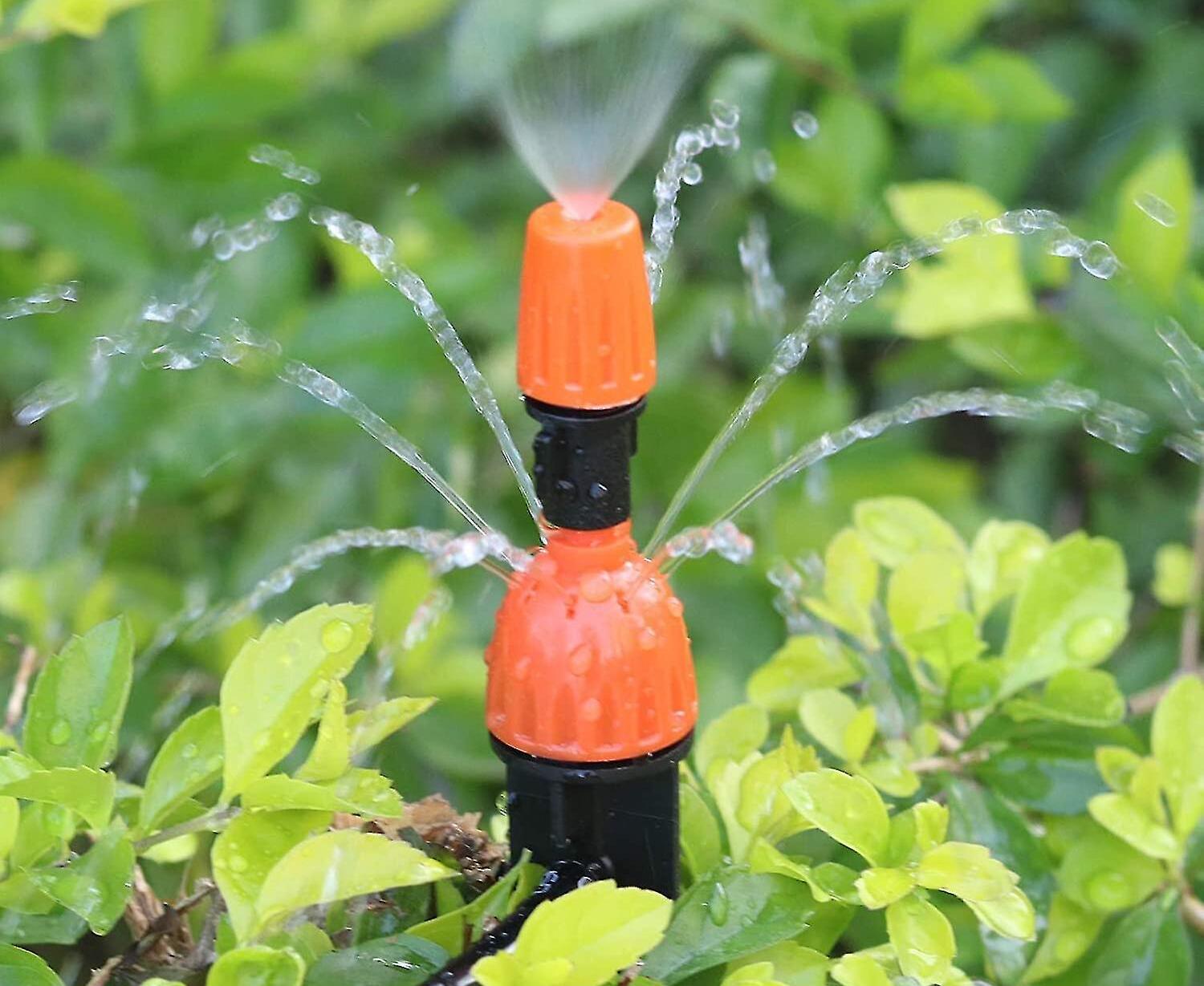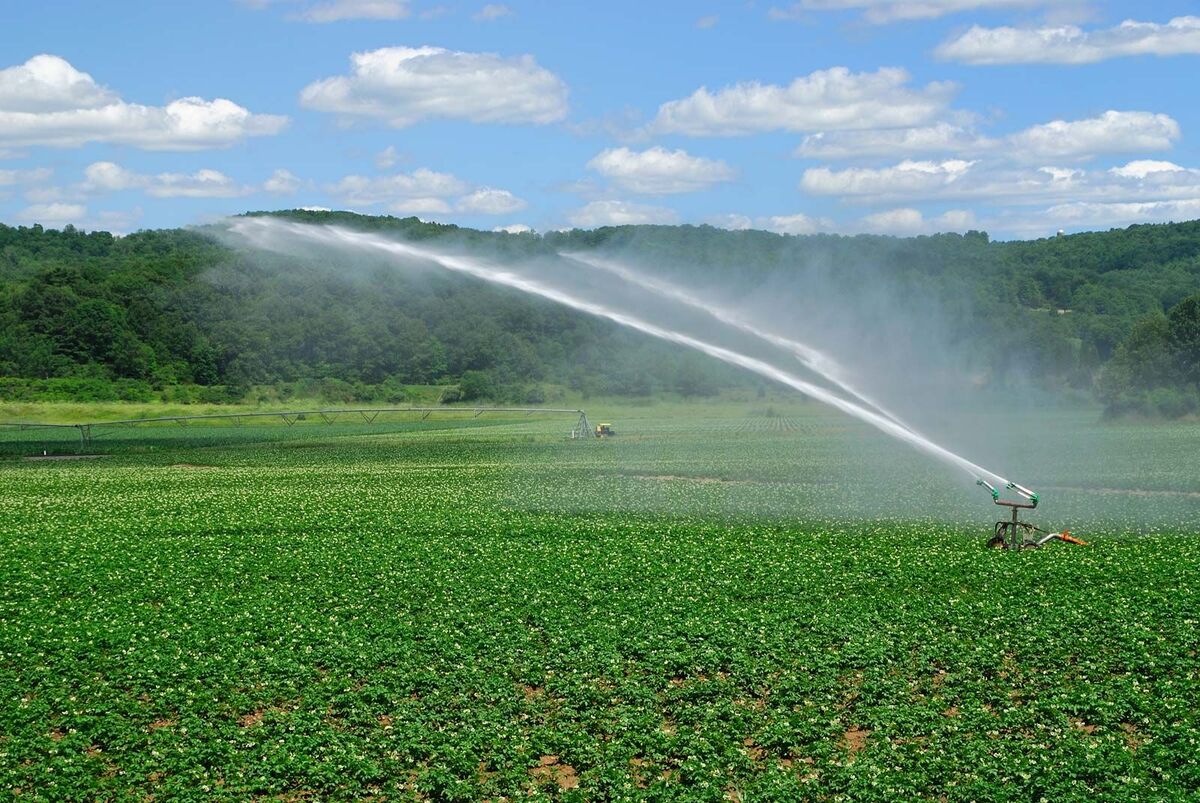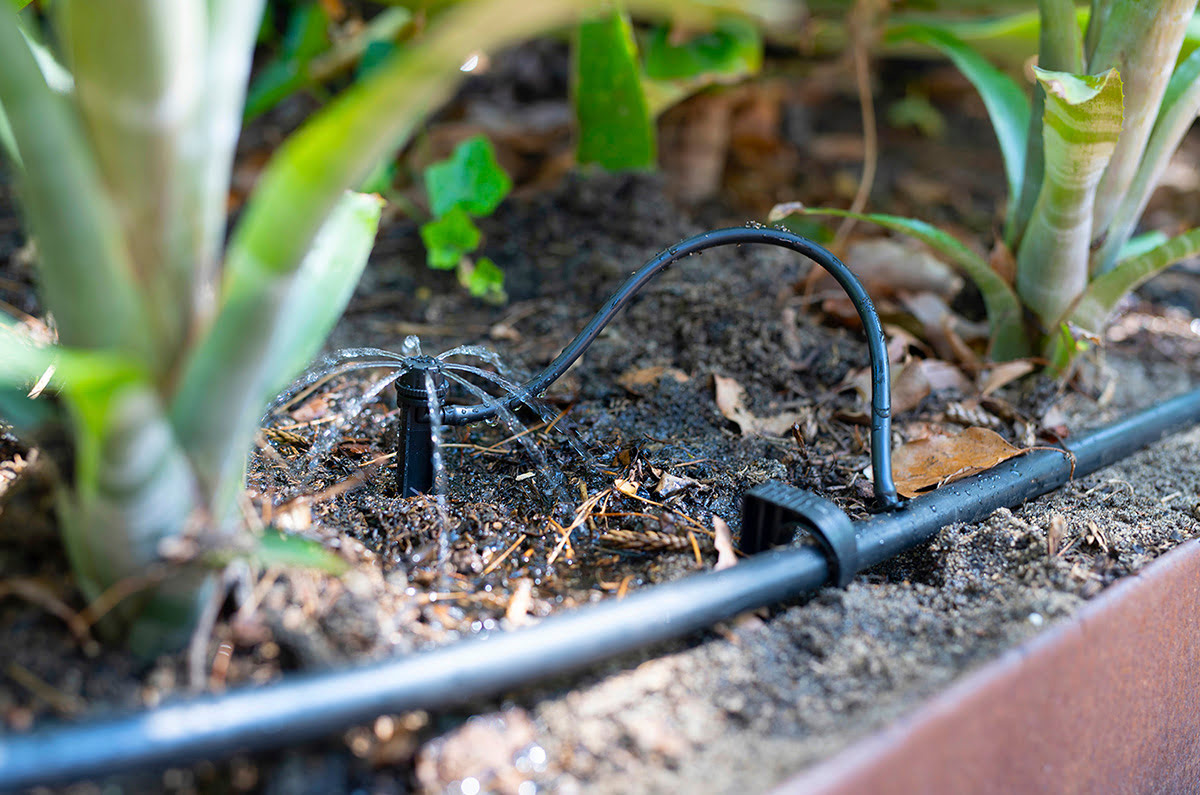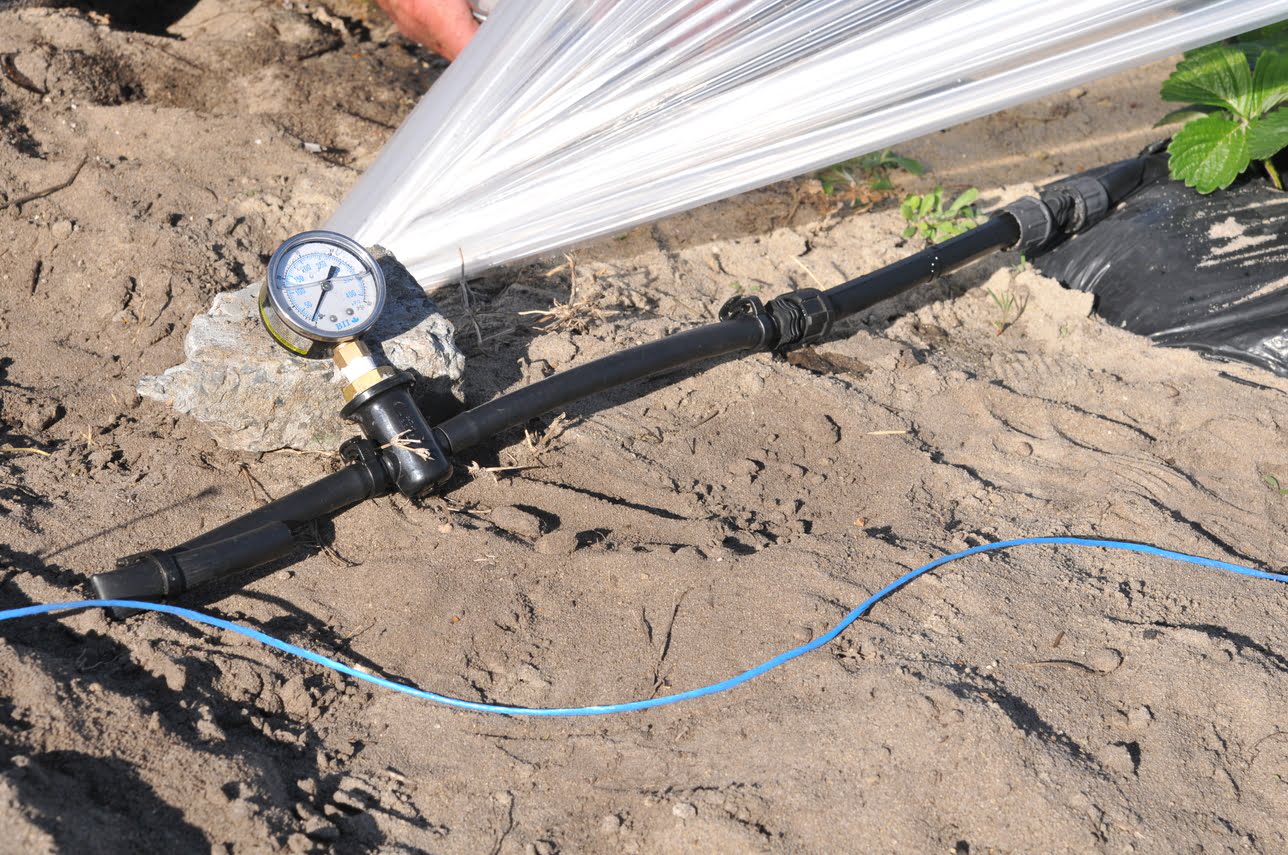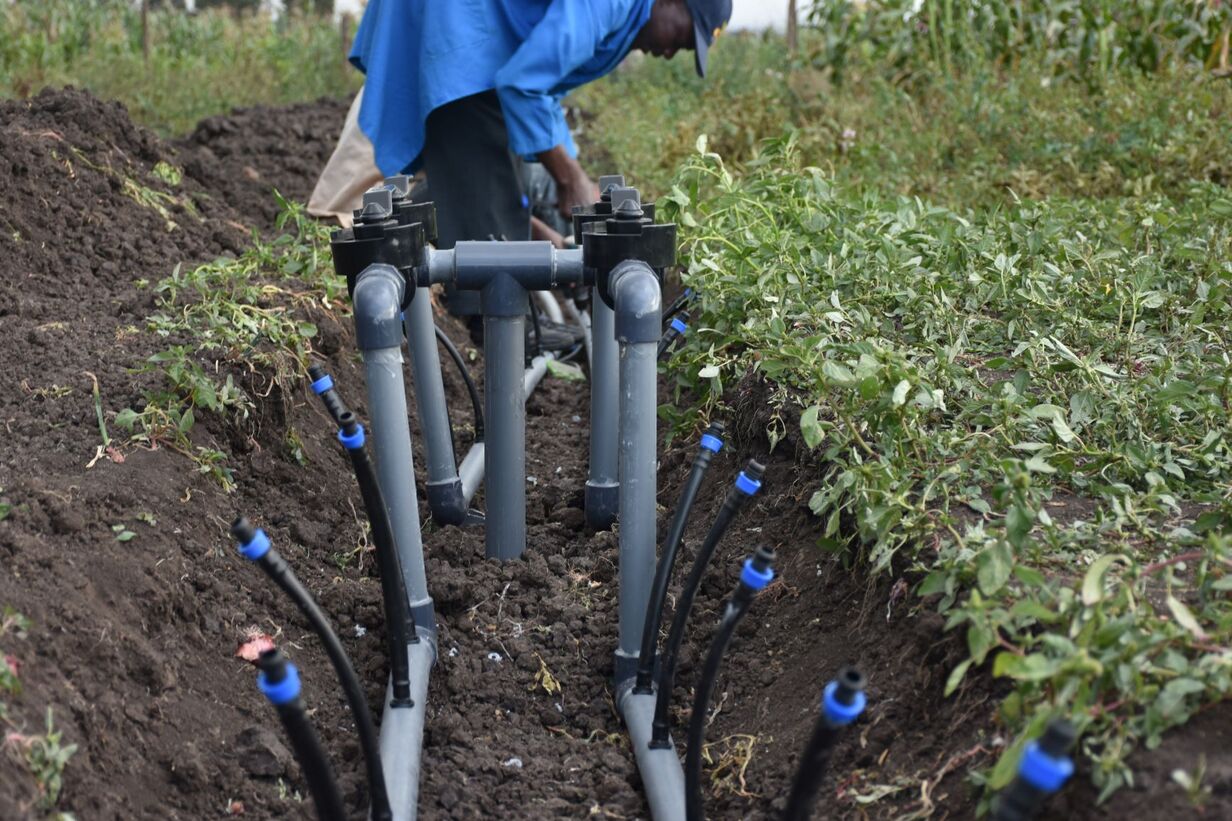Home>Gardening News and Trends>Latest News>What Is Drip Irrigation Used For
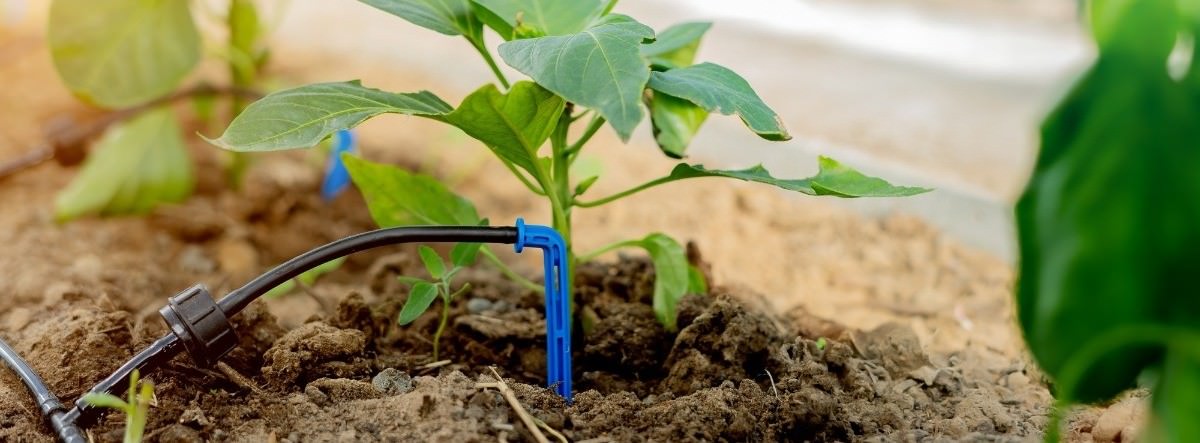

Latest News
What Is Drip Irrigation Used For
Modified: February 8, 2024
Discover the Latest News in Drip Irrigation and Its Applications. Learn How this Advanced Technique is Revolutionizing Water Efficiency and Maximizing Crop Yields.
(Many of the links in this article redirect to a specific reviewed product. Your purchase of these products through affiliate links helps to generate commission for Chicagolandgardening.com, at no extra cost. Learn more)
Table of Contents
Introduction
Drip irrigation is a state-of-the-art irrigation method that has gained significant popularity in recent years. It revolutionizes the way water is delivered to plants, offering numerous benefits over traditional irrigation systems. This technique involves the slow and precise application of water directly to the root zone of plants, leading to increased water efficiency, reduced water waste, and improved plant health.
Unlike traditional irrigation methods that spray or flood entire areas, drip irrigation delivers water in a controlled and targeted manner. This not only conserves water but also ensures that plants receive the optimal amount of moisture they need for healthy growth. Drip irrigation systems consist of a network of pipes, tubes, and emitters that are strategically placed throughout the field or garden, providing a regular supply of water to individual plants or specific areas.
The effectiveness of drip irrigation lies in its ability to minimize water loss due to evaporation, runoff, and wind drift. By delivering water directly to the root zone, where it is needed most, drip irrigation reduces soil surface wetting and prevents unnecessary water loss. This makes it an ideal choice for regions experiencing water scarcity or where water resources need to be conserved.
In addition to water conservation, drip irrigation also offers several other advantages. Firstly, it allows for precise control over the amount of water delivered to each plant, which prevents over- or under-watering. This targeted approach optimizes plant growth, minimizes stress, and reduces the risk of diseases caused by excessive moisture or prolonged drought.
Furthermore, drip irrigation systems enable the controlled application of fertilizers and nutrients directly to the root zone. This promotes efficient nutrient uptake, allowing plants to thrive and produce higher yields. Additionally, by delivering water and nutrients directly to the root zone, weed growth is minimized as water is not wasted on unplanted areas.
Overall, drip irrigation is a valuable tool for agricultural, residential, and commercial applications. This technique plays a crucial role in water conservation, plant health, and optimal crop production. In the following sections, we will delve deeper into the advantages of drip irrigation, explore its various applications, and discuss the types of crops that benefit the most from this innovative irrigation method.
Definition of Drip Irrigation
Drip irrigation is an irrigation technique that delivers water directly to the plant roots through a network of tubes and emitters. Unlike conventional irrigation methods, such as sprinkler systems or flood irrigation, drip irrigation provides a controlled and precise application of water, minimizing water waste and optimizing plant growth.
The key component of a drip irrigation system is the emitter, which regulates the flow rate and disperses water to individual plants. These emitters, commonly referred to as drippers, are strategically placed along the irrigation lines based on the spacing requirements of the crops being grown. They come in various designs, including pressure compensating, non-pressure compensating, and self-flushing emitters, allowing for flexibility in meeting specific irrigation needs.
The irrigation lines themselves, made of plastic or rubber materials, are laid out in a grid-like pattern along the field or garden. They are connected to a water source and supply lines, such as a central manifold or a header pipe, which provides a steady flow of water. The spacing between the irrigation lines depends on factors such as the type of crop, soil type, and water requirements.
In addition to emitters and irrigation lines, drip irrigation systems also include filters, pressure regulators, and valves to ensure proper functioning and prevent clogging. Filters remove debris, such as sediment and organic matter, from the water, preventing clogs in the emitters. Pressure regulators help maintain a consistent water pressure throughout the system, ensuring uniform water distribution. Valves enable control over the flow and timing of water delivery, allowing for customization based on crop needs and water availability.
Drip irrigation systems can be used in various settings, including large-scale agricultural fields, small-scale gardens, residential landscapes, and commercial greenhouses. They offer significant advantages over conventional irrigation methods, making them an increasingly popular choice for efficient and sustainable water management.
As the name suggests, drip irrigation refers to the slow and steady delivery of water directly to the plant roots, mimicking natural rainfall patterns. This method prevents excessive evaporation, runoff, and surface wetting, which are common drawbacks of other irrigation techniques. By minimizing water loss, drip irrigation conserves water resources and reduces the overall environmental impact of irrigation practices.
In the following sections, we will explore the benefits of drip irrigation in more detail, discussing how it contributes to water conservation and enhanced crop productivity. We will also delve into the applications of drip irrigation in various agricultural, residential, and commercial settings.
Advantages of Drip Irrigation
Drip irrigation offers numerous advantages over traditional irrigation methods, making it a preferred choice for farmers, gardeners, and landscapers. Let’s explore some of the key benefits:
- Water Conservation: One of the most significant advantages of drip irrigation is its ability to conserve water. By delivering water directly to the root zone, drip irrigation minimizes water loss due to evaporation, runoff, and wind drift. Compared to sprinkler systems, which often experience high evaporation rates, drip irrigation saves up to 50% of water. This is particularly crucial in arid regions or areas with limited water resources.
- Targeted Irrigation: Drip irrigation enables precise water delivery, ensuring that each plant receives the right amount of water it needs. The emitters can be adjusted to regulate the flow rate and pattern, allowing for customized irrigation based on individual plant requirements. This targeted approach eliminates overwatering and underwatering, optimizing plant health and minimizing water stress.
- Controlled Delivery: Drip irrigation systems provide control over the timing and frequency of water delivery. This flexibility allows farmers and gardeners to tailor irrigation schedules to match crop needs and weather conditions. By avoiding excessive watering during rainy periods or reducing irrigation during cooler seasons, drip irrigation promotes efficient water usage and prevents waterlogging.
- Improved Plant Health: By delivering water directly to the root zone, drip irrigation promotes healthier plant growth. The consistent moisture supply prevents plant stress and reduces the risk of disease or pest infestation. Additionally, drip irrigation eliminates leaf wetting, which can contribute to the spread of fungal diseases. Overall, plants irrigated with drip systems tend to have higher yields, better quality produce, and improved overall health.
- Reduced Weed Growth: Drip irrigation specifically targets plant roots, which helps to minimize weed growth. Since water is not wasted on unplanted areas, weed seeds are not encouraged to germinate and compete with crops for resources. This reduces the need for manual weeding or the use of herbicides, making drip irrigation an environmentally friendly option.
- Improved Nutrient Efficiency: Drip irrigation systems allow for controlled application of fertilizers and nutrients directly to the root zone. This ensures that plants receive the necessary nutrients without wastage or leaching into groundwater. As a result, nutrient uptake is optimized, leading to healthier plants with improved growth and yields.
- Flexible Installation: Drip irrigation systems can be tailored to fit various landscapes, including irregularly shaped fields or gardens. They can easily be installed in both flat and sloped terrains. This flexibility makes drip irrigation suitable for a wide range of agricultural, residential, and commercial applications.
The advantages of drip irrigation make it a valuable tool for sustainable water management, efficient crop production, and landscaping projects. It offers improved water efficiency, promotes plant health, and reduces environmental impact. In the following sections, we will explore the specific applications of drip irrigation in agriculture, residential and commercial landscaping, and greenhouse cultivation.
Water Conservation
Water scarcity is a global concern, and efficient water management has become increasingly crucial. Drip irrigation plays a significant role in water conservation by minimizing water waste and maximizing irrigation efficiency.
Unlike traditional irrigation methods that spray or flood large areas, drip irrigation delivers water directly to the root zone of plants. This targeted approach reduces water loss due to evaporation, runoff, and wind drift. By bypassing the soil surface, where water can quickly evaporate, drip irrigation ensures that water goes directly to the plant roots, where it is most needed.
Furthermore, drip irrigation eliminates the practice of surface water application, which can lead to significant water loss through evaporation and runoff. Surface irrigation methods, such as flood irrigation, can result in water wastage due to uneven distribution and improper timing. Drip irrigation minimizes these inefficiencies by delivering water slowly and directly to the root zone, preventing water from being wasted on areas that do not need it. This not only conserves water but also improves the overall water-use efficiency of the system.
Another aspect of water conservation achieved through drip irrigation is the prevention of soil erosion. When water is applied through sprinklers or flood irrigation, it can cause runoff and erosion, leading to soil degradation. Drip irrigation, on the other hand, delivers water slowly and evenly, allowing the soil to absorb it gradually. This helps maintain soil structure, preventing erosion and retaining valuable nutrients in the root zone.
In addition to mitigating water loss and erosion, drip irrigation systems can incorporate innovative technologies to further optimize water conservation. Soil moisture sensors and weather-based controllers can be integrated into the system, allowing for real-time monitoring of soil moisture levels and adjusting irrigation schedules accordingly. This prevents overwatering and ensures that plants receive water only when necessary.
Overall, drip irrigation is an effective water conservation solution. By delivering water directly to the roots of plants, minimizing water loss, and incorporating advanced technologies, it provides a sustainable and efficient irrigation method for various agricultural, residential, and commercial applications. In the following sections, we will explore the specific agricultural, landscaping, and greenhouse applications where drip irrigation excels in water conservation and plant health.
Targeted Irrigation
Drip irrigation excels in providing targeted irrigation, ensuring each plant receives the precise amount of water it needs for optimal growth and productivity. This precise water delivery eliminates the inefficiencies of traditional irrigation methods, such as overspray or uneven distribution.
With drip irrigation, water is delivered directly to the root zone of plants through emitters located at the base of each plant or along the irrigation lines. The flow rate and pattern of these emitters can be adjusted to match the water requirements of different crops. This level of customization allows farmers and gardeners to cater to the specific needs of individual plants, taking into account factors such as plant size, growth stage, and variety.
This targeted approach to irrigation not only ensures that each plant receives the required amount of water but also minimizes water waste. Unlike overhead sprinklers that deliver water across a wide area, drip irrigation precisely directs water to the plant roots, avoiding unnecessary wetting of soil surfaces and foliage. This reduces the risk of diseases caused by prolonged leaf wetness, such as fungal infections.
By delivering water directly to the root zone, drip irrigation also prevents water evaporation from the soil surface. This is particularly beneficial in areas with high temperatures or windy conditions, where conventional irrigation methods can lead to significant water loss due to evaporation and wind drift. Drip irrigation mitigates these losses by keeping water in the root zone, where plants can readily absorb it.
Moreover, targeted irrigation with drip systems promotes efficient water use by avoiding unnecessary watering of unplanted areas or non-crop spaces. With the ability to place emitters precisely where they are needed, drip irrigation systems can be designed to irrigate specific sections of a field or garden, leaving non-cultivated areas dry. This reduces water usage and reduces the competition between crops and weeds for available moisture.
The precision and control offered by drip irrigation systems also extend to fertigation, which is the practice of delivering fertilizers or nutrients through the irrigation system. By incorporating fertigation into a drip irrigation system, farmers can ensure that nutrients are applied directly to the root zone, where they are most efficiently absorbed by plants. This enhances nutrient uptake and minimizes nutrient losses, promoting healthier and more productive crops.
Overall, targeted irrigation through drip systems optimizes water usage, reduces water waste, and promotes healthier plant growth. This level of precision and control over irrigation is especially valuable for agricultural operations, as it enhances crop productivity while conserving water resources. In the following sections, we will explore the specific agricultural, residential, and commercial applications where drip irrigation proves to be highly effective in delivering targeted irrigation.
Controlled Delivery
Drip irrigation systems offer controlled delivery of water, allowing farmers, gardeners, and landscapers to have precise control over the timing and amount of water applied to their plants. This level of control contributes to the efficient use of water resources and ensures optimal plant growth.
Unlike traditional irrigation methods that rely on manual or time-based watering schedules, drip irrigation systems can be equipped with timers, controllers, or sensors that automate and regulate the water delivery process. These devices enable users to set specific watering schedules based on the seasonal needs of their crops or landscape. This automation not only ensures consistent and reliable watering but also saves time and effort in manual irrigation.
With drip irrigation, water is supplied in small, frequent doses, allowing for targeted irrigation. This controlled delivery prevents water runoff and leaching, as the water is absorbed by the soil at a rate that matches its infiltration capacity. As a result, the water stays in the root zone, providing plants with a steady and consistent supply of moisture.
Furthermore, drip irrigation systems allow for the adjustment of flow rates and pressure levels based on the specific needs of different crops or areas within a landscape. This flexibility enables users to cater to the water requirements of different plant species, growth stages, or soil conditions. For instance, young seedlings may require lower flow rates, while established plants may benefit from slightly higher flow rates to ensure adequate water penetration.
In addition to controlling the amount of water delivered, drip irrigation also allows for the precise application of fertilizers and nutrients directly to the root zone. Through the integration of a fertigation system, farmers and gardeners can conveniently supply plants with the necessary nutrients during the irrigation process. This targeted delivery ensures efficient nutrient uptake by the plants and reduces wastage or leaching of nutrients into the environment.
Another advantage of controlled delivery in drip irrigation is the ability to adapt the watering schedule based on weather conditions. Advanced drip irrigation systems can be equipped with weather-based controllers or sensors that monitor factors such as temperature, humidity, and rainfall. This data is used to automatically adjust the irrigation schedule, preventing overwatering during periods of rain or cooler temperatures. By aligning water delivery with actual plant water requirements, drip irrigation promotes efficient water usage and prevents water stress.
The controlled delivery capabilities of drip irrigation systems provide users with greater control and flexibility, resulting in optimized water usage, enhanced plant health, and reduced environmental impact. Whether it is for agricultural, residential, or commercial applications, the ability to precisely regulate water and nutrient delivery is a valuable advantage of drip irrigation systems.
Types of Crops Suitable for Drip Irrigation
Drip irrigation can be used with a wide variety of crops, ranging from fruits and vegetables to field crops and ornamental plants. However, certain types of crops are particularly well-suited for this irrigation method due to their water requirements, root structures, and sensitivity to moisture levels.
Fruits and vegetables are commonly grown using drip irrigation because they often require precise and consistent watering to ensure optimal growth and fruit development. Crops like tomatoes, peppers, cucumbers, strawberries, and melons thrive with drip irrigation due to its ability to provide consistent moisture directly to the root zone. This promotes even water uptake and minimizes the risk of fruit diseases caused by overhead irrigation.
Drip irrigation is also highly suitable for field crops such as corn, soybeans, cotton, and wheat. These crops have widespread root systems that benefit from the steady and controlled water supply provided by drip systems. Additionally, drip irrigation can reduce weed competition in these crops since water is applied only to the desired planting rows, preventing weed growth in non-cultivated areas.
Ornamental plants, including flowers, shrubs, and trees, also benefit from drip irrigation. The controlled delivery of water ensures that these plants receive consistent moisture, promoting healthy growth and vibrant blooms. Drip irrigation can be particularly useful in landscape projects where water conservation and efficient irrigation are essential.
In addition to these common crop types, drip irrigation can also be used for specialized crops such as vineyards, orchards, and nursery plants. Grapes, for example, thrive with drip irrigation as it allows for precise water application near the grapevine roots. Orchards, including fruit trees like apples, peaches, and citrus, greatly benefit from drip irrigation systems by providing water directly to the root zones, improving tree health and fruit quality.
Drip irrigation is also valuable for greenhouse cultivation, where crops are grown in a protected environment. The controlled delivery of water allows for precise irrigation in greenhouse settings, ensuring that plants receive adequate moisture without wasting water. It can be used for a wide range of greenhouse crops, including vegetables, herbs, flowers, and even hydroponic systems.
In summary, while drip irrigation can be employed for various crop types, it is particularly well-suited for fruits, vegetables, field crops, ornamental plants, vineyards, orchards, and greenhouse cultivation. The targeted and efficient water delivery of drip irrigation contributes to healthier plants, improved yields, and reduced water consumption across these crop types.
Agricultural Applications
Drip irrigation has a wide range of agricultural applications, contributing to sustainable and efficient water management in crop production. Its benefits make it an attractive option for farmers looking to optimize irrigation practices and improve productivity.
In traditional agriculture, drip irrigation offers several advantages over conventional irrigation methods. It is particularly beneficial in regions with limited water resources or those experiencing water scarcity. By delivering water directly to the root zone, drip irrigation significantly reduces water wastage through evaporation, runoff, and deep percolation. This water-saving aspect of drip irrigation is paramount in arid and semi-arid regions, where water conservation is crucial for sustainable agriculture.
Drip irrigation is highly suitable for row crops, including vegetables, fruits, and field crops. The precise and localized water application of drip systems minimizes weed growth and reduces competition for water between crops and weeds. This reduces the need for manual weeding or the use of herbicides, contributing to sustainable and environmentally friendly farming practices.
In addition to promoting water conservation and weed control, drip irrigation improves nutrient efficiency in crops. The ability to apply fertilizers directly to the root zone through fertigation enhances the uptake of essential nutrients by plants. This results in healthier crops with improved vitality and higher yields.
One notable agricultural application of drip irrigation is in the cultivation of high-value crops. Drip systems are commonly used in vineyards and orchards, where precise water delivery directly to the root zone is crucial for optimal grape and fruit growth. Drip irrigation ensures that these specialty crops receive the necessary moisture and nutrients, contributing to the production of high-quality fruits and wines.
Moreover, drip irrigation can be easily integrated with other agricultural practices such as mulching and plastic film coverings. The combination of drip irrigation with mulch or plastic film reduces evaporation, suppresses weed growth, and helps maintain soil moisture levels. This further enhances water efficiency and promotes healthy plant growth.
Drip irrigation is also compatible with a range of irrigation scheduling methods, including soil moisture-based approaches and climate data-driven models. By monitoring soil moisture levels and considering weather conditions, farmers can fine-tune their drip irrigation systems to provide water precisely when and where crops need it the most.
Overall, drip irrigation is a valuable tool in agricultural applications. Its ability to conserve water, provide targeted irrigation, enhance nutrient efficiency, and integrate with other farming practices makes it an essential component in modern and sustainable farming systems. As we move forward, the adoption of drip irrigation is crucial for ensuring food security, reducing water stress, and improving overall agricultural productivity.
Residential and Commercial Landscaping
Drip irrigation is highly advantageous for both residential and commercial landscaping projects, offering efficient and precise water delivery for a variety of plants, trees, and shrubs. It revolutionizes traditional watering methods, providing numerous benefits for maintaining beautiful and sustainable landscapes.
In residential landscaping, drip irrigation systems have become increasingly popular due to their water-saving capabilities and ease of installation. Homeowners can achieve a lush and vibrant landscape while conserving water and reducing water bills. Drip systems allow for the targeted watering of individual plants, ensuring that water reaches the root zone where it is needed most. This reduces water waste from overspray, runoff, and evaporation, benefitting both the environment and the homeowner’s budget.
Drip irrigation is especially useful in areas with water restrictions or arid climates. It provides plants with consistent moisture, even during periods of limited rainfall. This enables homeowners to maintain healthy and thriving landscapes, even in conditions where conventional irrigation methods would struggle to meet the water requirements of plants.
Another advantage of drip irrigation in residential landscaping is its ability to prevent soil erosion and control weed growth. By delivering water directly to the root zone, drip systems minimize water runoff and soil erosion that can occur with sprinkler systems. Furthermore, since water is only applied to the desired planting areas, drip irrigation significantly reduces weed growth in non-cultivated areas.
In commercial landscaping, such as parks, golf courses, and office complexes, drip irrigation offers several advantages over other irrigation methods. It ensures efficient water usage, reduces water waste, and minimizes the need for labor-intensive manual watering. Drip systems can be tailored to specific landscape designs, delivering water precisely to each plant while avoiding unnecessary watering of hardscapes or non-vegetated areas.
Commercial properties with extensive landscapes can benefit from the flexibility and scalability of drip irrigation systems. These systems can be carefully planned and designed to meet the unique water requirements of various plantings, including turfgrass, flower beds, shrubs, and trees. The controlled delivery of water to the root zone promotes overall plant health, reduces stress, and minimizes the risk of disease or pest outbreaks.
Overall, drip irrigation is a sustainable and efficient irrigation solution for residential and commercial landscaping. Its ability to conserve water, prevent soil erosion, control weed growth, and ensure precise water delivery makes it an ideal choice for maintaining beautiful and environmentally friendly landscapes. By embracing drip irrigation in landscaping projects, homeowners and commercial property owners can create visually appealing outdoor spaces while minimizing water usage and reducing environmental impact.
Greenhouse Cultivation
Drip irrigation is a valuable irrigation method for greenhouse cultivation, providing precise and efficient water delivery for a wide range of crops grown in controlled environments. Greenhouses leverage the benefits of drip irrigation to optimize water usage, ensure consistent plant growth, and maximize crop yields.
One of the main advantages of drip irrigation in greenhouse cultivation is its ability to deliver water directly to the root zone of plants. This targeted approach ensures that plants receive the necessary moisture without wetting the foliage, reducing the risk of fungal diseases. By keeping the leaves dry, drip irrigation systems create an environment that is less favorable for disease development, allowing crops to grow healthier and minimizing the need for chemical treatments.
Drip irrigation systems in greenhouses also contribute to water conservation. The controlled delivery of water ensures that only the necessary amount is supplied to the plants, minimizing wastage through evaporation and runoff. This is particularly beneficial in closed greenhouse systems where water resources need to be managed efficiently. By conserving water, drip irrigation enables greenhouse growers to operate sustainably and reduce their environmental impact.
Furthermore, drip irrigation systems can be easily integrated with other greenhouse technologies such as climate control systems and fertigation systems. The combination of these systems allows for precise control over irrigation schedules, nutrient delivery, and environmental conditions. This integration facilitates the optimization of crop growth and health, enabling greenhouse operators to achieve higher yields and better crop quality.
The flexibility of drip irrigation also makes it well-suited for greenhouse cultivation. The irrigation lines and emitters can be easily adjusted or relocated to accommodate different plant spacing or changing crop configurations. This adaptability is especially valuable when growing a diverse range of crops in the same greenhouse or when rotating crops throughout the year.
Additionally, drip irrigation enables the precise application of fertilizers and nutrients directly to the root zone of plants. This promotes efficient nutrient uptake and minimizes nutrient losses, leading to improved crop health and higher yields. The integration of fertigation systems with drip irrigation allows for the controlled and accurate delivery of the necessary nutrients, optimizing plant nutrition and reducing the need for manual fertilization.
Overall, drip irrigation has proven to be a reliable and efficient irrigation method for greenhouse cultivation. Its ability to provide targeted and controlled water delivery, prevent leaf wetting, conserve water, and integrate with other greenhouse systems makes it an essential component in modern greenhouse operations. By utilizing drip irrigation in greenhouse cultivation, growers can maximize their crop yields, conserve resources, and ensure sustainable and profitable production.
Conclusion
Drip irrigation offers a multitude of advantages for various applications, ranging from agricultural fields to residential gardens to commercial landscapes and greenhouse cultivation. Its ability to conserve water, provide targeted irrigation, promote plant health, and allow for precise nutrient delivery makes it a highly effective and sustainable irrigation method.
With drip irrigation, water is delivered directly to the root zone of plants, minimizing water loss through evaporation, runoff, and deep percolation. This conserves water resources and helps address the challenges of water scarcity and limited availability in many regions.
The targeted irrigation provided by drip systems ensures that each plant receives the appropriate amount of water, reducing the risk of overwatering or underwatering. This promotes plant health, minimizes stress, and improves crop productivity.
The controlled delivery of water and nutrients in drip irrigation allows for precise customization of irrigation schedules and optimizes nutrient uptake by plants. This ensures efficient water and nutrient use, leading to healthier and more productive crops.
Drip irrigation is suitable for various crop types, including fruits, vegetables, field crops, ornamental plants, vineyards, orchards, and greenhouse cultivation. Its flexibility and scalability make it adaptable to different agricultural and horticultural practices, promoting sustainable and efficient water management.
In conclusion, drip irrigation is a valuable tool for enhancing water efficiency, conserving resources, and optimizing plant growth in various settings. By embracing this innovative irrigation method, farmers, gardeners, and landscapers can contribute to sustainable agriculture, create beautiful and healthy landscapes, and ensure the efficient use of water for crop production.
